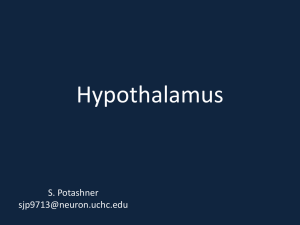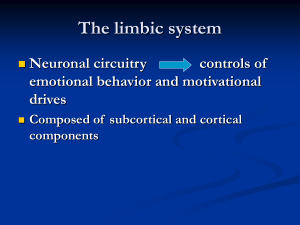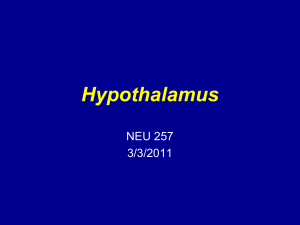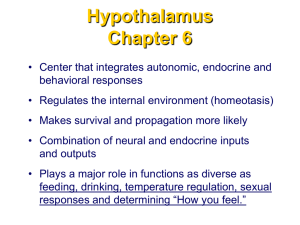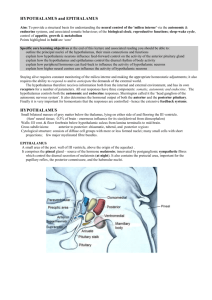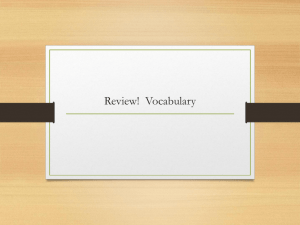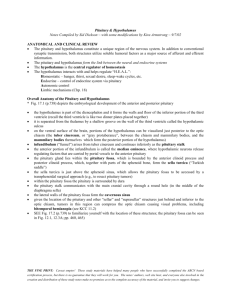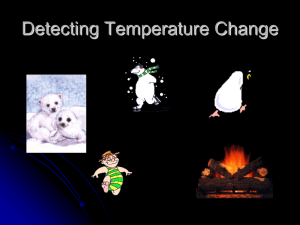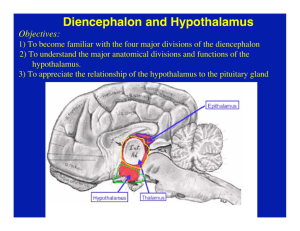Objectives 39 - U
advertisement
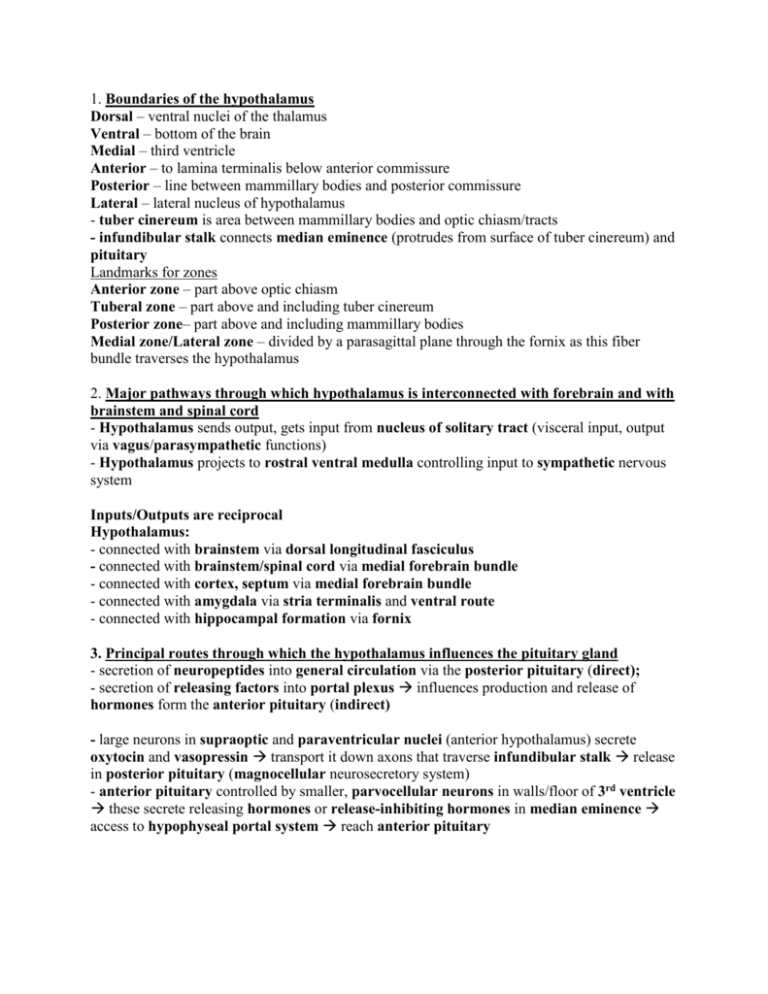
1. Boundaries of the hypothalamus Dorsal – ventral nuclei of the thalamus Ventral – bottom of the brain Medial – third ventricle Anterior – to lamina terminalis below anterior commissure Posterior – line between mammillary bodies and posterior commissure Lateral – lateral nucleus of hypothalamus - tuber cinereum is area between mammillary bodies and optic chiasm/tracts - infundibular stalk connects median eminence (protrudes from surface of tuber cinereum) and pituitary Landmarks for zones Anterior zone – part above optic chiasm Tuberal zone – part above and including tuber cinereum Posterior zone– part above and including mammillary bodies Medial zone/Lateral zone – divided by a parasagittal plane through the fornix as this fiber bundle traverses the hypothalamus 2. Major pathways through which hypothalamus is interconnected with forebrain and with brainstem and spinal cord - Hypothalamus sends output, gets input from nucleus of solitary tract (visceral input, output via vagus/parasympathetic functions) - Hypothalamus projects to rostral ventral medulla controlling input to sympathetic nervous system Inputs/Outputs are reciprocal Hypothalamus: - connected with brainstem via dorsal longitudinal fasciculus - connected with brainstem/spinal cord via medial forebrain bundle - connected with cortex, septum via medial forebrain bundle - connected with amygdala via stria terminalis and ventral route - connected with hippocampal formation via fornix 3. Principal routes through which the hypothalamus influences the pituitary gland - secretion of neuropeptides into general circulation via the posterior pituitary (direct); - secretion of releasing factors into portal plexus influences production and release of hormones form the anterior pituitary (indirect) - large neurons in supraoptic and paraventricular nuclei (anterior hypothalamus) secrete oxytocin and vasopressin transport it down axons that traverse infundibular stalk release in posterior pituitary (magnocellular neurosecretory system) - anterior pituitary controlled by smaller, parvocellular neurons in walls/floor of 3rd ventricle these secrete releasing hormones or release-inhibiting hormones in median eminence access to hypophyseal portal system reach anterior pituitary 4. Organization in hypothalamus of warm-sensitive and cold-sensitive neurons and heatconservation and heat-retention areas - hypothalamus is a survival/propagation tool - hypothalamic function involves servomechanism – some regulated parameter is compared to a desired value called a set point - human body temperature has a set point once difference between ambient temperature and set point passes TH value hypothalamic control sets in until difference is reduced - internal thermostat located in anterior hypothalamus and preoptic area; contains two populations of temperature-sensitive neurons: warm-sensitive and cold-sensitive - if temp of blood passing by anterior/preoptic hypothalamus increases preoptic area heat-dissipation mechanisms including sweating, vasodilation, and behavioral responses (finding cool place) - info about diminished core temperature medial forebrain bundle posterior hypothalamus activation of heat-conserving and heat-generating mechanisms including shivering, vasoconstriction, metabolic changes, and behavioral responses (finding warmer place, closing window) -thermoregulator areas of hypothalamus affect endocrine mechanisms that affect body temperature, such as thyroid and adrenal stimulating hormones; effect mediated by hypothalamic-hypophyseal system (vascular system that carries regulating factors from hypothalamus to pituitary gland) 5. Regulation of thirst and drinking behavior - signals that water needs to be consumed or conserved come from increased tissue osmolality and decreased blood volume - increasing body water can be accomplished by drinking more or excreting less - anterior hypothalamic neurons are directly sensitive to tissue osmolality send info about increased osmolality to supraoptic/paraventricular nuclei increased vasopressin (ADH) secretion increase water resorption from kidney; these neurons are called osmoreceptors (located in region rostral to 3rd ventricle) - OVLT (organum vasculosum of the lamina terminalis): circumventricular organs (lacks bloodbrain barrier); contains osmoreceptive neurons; OVLT output to medial preoptic nucleus to lateral hypothalamus activate motor programs related to drinking behavior via connections to basal ganglia and brainstem reticular nuclei; similar outputs to limbic structures for more complex drinking behaviors - Medial preoptic area contains osmoreceptive neurons; this region receives info from baroreceptors in heart about blood volume and from internal organs via nucleus of solitary tract - decreased blood volume stimulates vascular receptors direct info to hypothalamus via nucleus of solitary tract; humoral message by activating renin-angiotensin system angiotensin in blood reached brain subfornical organ (SFO) is circumventricular living in ceiling of third ventricle under fornix stimulates drinking behavior via output to medial preoptic region - osmotic/volumetric thirst describes loss of water from intracellular/intravascular fluid compartments 6. Circadian rhythms - many set points oscillate with a period of 24 hours - circadian rhythms for body temperature, hormone levels, activity, and sleep-wake cycle - master clock for these rhythms resides in a tiny hypothalamic nucleus called the suprachiasmatic nucleus, which is above the optic chiasm; its natural period is a bit longer than 24 hours, but direct retinal input entrains the period to 24 hours
